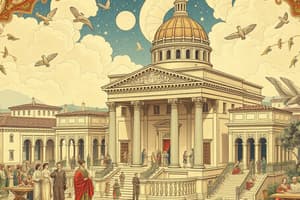Podcast
Questions and Answers
What geographical feature contributed to Rome's trading and transportation capabilities?
What geographical feature contributed to Rome's trading and transportation capabilities?
- Being a landlocked region
- Proximity to large deserts
- Surrounding bodies of water like seas
- Rome's location surrounded by water facilitated international trading and transport.
- Mountains surrounding the city
What role do Praetors play in the Roman government?
What role do Praetors play in the Roman government?
- They are responsible for maintaining public buildings.
- They manage the financial resources of the government.
- They serve as judges and implement the law. (correct)
- They act as representatives of the Plebeians.
Which group in Roman society had the largest representation in government positions?
Which group in Roman society had the largest representation in government positions?
- Plebian representatives in the Senate.
- Servants and laborers.
- Military leaders.
- The wealthy Patricians. (correct)
How does the veto power function for the Tribunes in the Roman Republic?
How does the veto power function for the Tribunes in the Roman Republic?
What was a significant characteristic of the Roman Republic compared to a democracy?
What was a significant characteristic of the Roman Republic compared to a democracy?
What key geographical feature contributed to Rome's economic activities?
What key geographical feature contributed to Rome's economic activities?
Flashcards
Roman Republic's Social Divisions
Roman Republic's Social Divisions
The Republic of Rome was governed by two groups: the wealthy Patricians and the common Plebeians. However, only the Patricians had political power, making the system unjust.
Republic
Republic
A representative form of government where elected officials represent the people's interests.
Consuls
Consuls
Consuls were the chief executives of the Roman Republic, elected for one-year terms and responsible for leading the military and overseeing the government.
Praetors
Praetors
Signup and view all the flashcards
Tribunes
Tribunes
Signup and view all the flashcards
Study Notes
Roman Republic
- Rome is located in Europe, the capital of Italy, and home to Vatican City, the smallest country.
- Italy is a peninsula shaped like a boot, bordered by the Adriatic, Tyrrhenian, and Mediterranean Seas.
- Rome's initial development centered on the Tiber River, facilitating trade and transportation.
Roman Republic Government Structure
- Republic: A representative government wherein elected officials represent the majority.
- Classes: Roman society was divided into Patricians (wealthy elite) and Plebeians (common people). Only Patricians held significant government power.
- Government Positions:
- Consuls: Two chief executive officers, elected annually.
- Praetors: Judges responsible for enforcing laws (8 positions).
- Aediles: Overseeing public buildings and roads (16 positions).
- Quaestors: Treasurers managing finances (20 positions).
- Tribunes: Representatives for the Plebeians. They held veto power and were observers in meetings. Their roles though, were often disregarded.
Roman Economy and Society
- Importance of Water: Water was central to Rome's economy, facilitating trade and daily life.
- Economic Activities: Trading and water-related professions were vital to the Roman way of life.
Studying That Suits You
Use AI to generate personalized quizzes and flashcards to suit your learning preferences.


